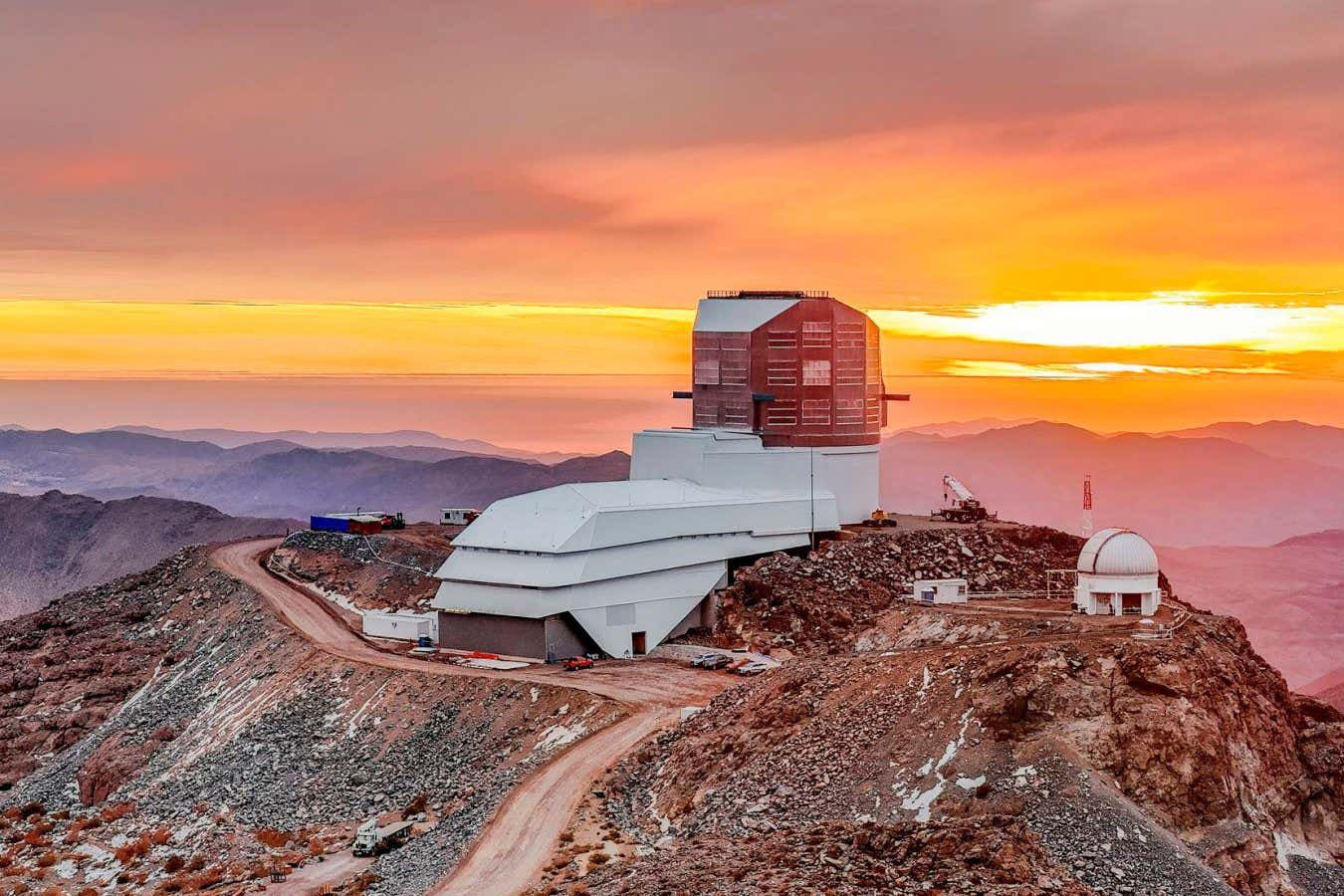
The Vera C. Rubin Observatory is about to open a new eye on the universe
Olivier Bonin/SLAC National Accelerator Laboratory
On top of Cerro Pachón, a Chilean mountain that reaches more than 2600 metres above sea level, the air is thin. I have to catch my breath as we climb the stairs inside the dome of the Vera C. Rubin Observatory. It is cool and quiet and enormous, a bit like a cathedral – until the entire dome booms into motion around us and opens to the sky.
Night has fallen and above us sit more stars than I have ever seen with my own eyes. The Milky Way shines brighter than usual, and I can just make out two of its galactic neighbours, the Small and Large Magellanic Clouds. However, the Rubin telescope can see far, far more. It is a behemoth: it holds world records for the largest digital camera and the largest lens, and weighs in at 350 metric tons. It is a reflecting telescope, gathering light via mirrors, the largest of which is 8.4 metres across – as wide as they could make it because a tunnel on the way up to the summit is about 8.5 metres across.
Yet despite such heft, this telescope can move extremely fast – and that will let it revolutionise what we know about our own solar system, our galaxy and the universe. Every three nights, it will complete a survey of the southern sky. Previous all-sky surveys have taken months or weeks, but the Rubin will do one in less than half a week, over and over for a decade. The result will be a kind of cosmic timelapse.
“By taking the entire sky every three days, you can stack those images together to go deeper,” says observatory scientist Kevin Reil. “So after 10 years, you’ve gone very, very deep, very, very far into the universe, very far back in time. But you’re also getting the structure of the universe,” he says.
Understanding that structure is one of the observatory’s missions – to find out more precisely how dark matter warps the universe. The telescope’s namesake, astronomer Vera Rubin, started this journey. In the 1970s, her observations of galaxies rotating made it clear that visible matter only makes up a fraction of the universe. She found that stars on the outer edges of galaxies were moving too fast – according to Kepler’s laws, they really should have been slower than the stars close to galactic centres.
After years of observations and calculations, the only way to square this was to assume that there had to be more matter than we could see. This unseen stuff was named dark matter and astronomers now believe that there is roughly five times as much of it in the cosmos as ordinary matter, and its gravitational pull shapes the universe we see.
“The visible matter actually follows where the dark matter is, not the other way around,” says Stephanie Deppe at the observatory. Galaxies are thought to be laid out on what astronomers call the cosmic web, comprising interconnecting filaments of dark matter that gravitationally trap the stars we can see. The images from Rubin will give us our best ever look at this web.
Mapping the web will also help us pin down the true nature of dark matter. Is it hot and made of light, fast-moving particles or cold and made of particles that clump more easily? “You can look for little disruptions like kinks in the stellar streams,” says Deppe. These will show us where clumps of dark matter busted through a filament. Understanding how big a clump would be able to do so will narrow down which type of dark matter might be out there. The structure of the cosmic web will also give us a better sense of the effects of dark energy, the propulsive force accelerating the expansion of the universe.

Summit staff installing the Vera C. Rubin Observatory’s commissioning camera in August 2024
Rubin Observatory/NSF/AURA/H. Stockebrand
The excitement over this precision astronomy is palpable at the observatory. During the night I am there for observations, everyone is a little giddy. In the kitchen near the telescope’s control room, I hear excited chatter. One of the telescope operators is almost bouncing as he says: “I hope we get ‘on sky’ tonight.” That is observatory lingo for opening up the telescope’s shutter and taking images. “Oh, we will,” says his colleague, smiling into a mug of tea. As the sun goes down, we all cross our fingers for the clouds to clear.
Once they do, the control room is a hive of activity. The operators are still working out the kinks with the telescope, getting the images into proper focus. Every 30 seconds or so, another one comes through, along with a whooshing sound that signals the shutter has opened followed by another whoosh when it has closed. The telescope takes a snapshot of part of the sky and then zips to the next spot and takes another, building up a grid that can be stitched together.
Everything is going swimmingly until suddenly there is a glitch. To make the most out of a telescope that can move so quickly, the observatory uses an automated program that chooses where to point the telescope next, based on things like weather or the phase of the moon. But for a moment, this system isn’t working. The operators have a video chat with scientists at the base camp a couple of hours’ drive down the mountain. Together, they dive into the code for the system to find the problem. The fix is sent around 20 minutes later and they are back up and running. The regular cadence of the shutter whooshing starts up again and the images keep pouring in.
“This is one of the best nights we’ve had, this is just cruising. This is such good data right now,” says Eli Rykoff, a calibration scientist. “I hope the processing people right now are appreciating us giving them high-quality science images.”
Once the images are made at the telescope, they begin a long but very quick journey across the globe. They head down the mountain along the first stretch of 103,000 kilometres of fibre-optic cables that run either to the Atlantic or Pacific oceans and then underwater to the US. The images pass through a hub in Florida and then end up at the SLAC National Accelerator Laboratory in California.
Each image is around 32 gigapixels, which is about the size of a 4K movie, and arrives within around 10 seconds, says William O’Mullane, who manages the data for the observatory. From there, the data goes to facilities in the UK and France that make the images available to scientists around the world.
Perhaps the most urgent analysis will be done on fast-moving objects. The night sky pulses, blips and changes in ways we can’t always predict – and the Rubin Observatory is hot on its tail. We have never had the ability to capture these movements so quickly, and doing so will let us see those rapidly changing objects in as close to real time as you can get. The telescope will track asteroids and comets that are zipping across the sky, both those that make up the main asteroid belt between Mars and Jupiter and those much further out called trans-Neptunian objects.
“Currently, we only know of a few thousand objects” in the Kuiper Belt and the Oort cloud, says Deppe. “Rubin’s going to increase by probably 10-fold the number of objects that we know out there.”
It will also help us track any potential threats from near-Earth objects, increasing the known examples of these from roughly 30,000 to around 100,000. And we could even catch fast-moving interstellar objects like ‘Oumuamua, which whizzed through the solar system in 2017, or the comet Borisov that flew by in 2019.
This kind of solar system census could also answer the question of whether there is, indeed, a Planet Nine. Tantalising evidence for such a world – one five to 10 times the mass of Earth in the outer solar system – comes from Kuiper Belt objects that have unusual but similar orbits. Simulations have shown that a planet could be to blame, but there is no direct evidence yet.
That may soon change. “Either Rubin is going to directly find Planet Nine, it’s going to find indisputable evidence for it, or it’s going to totally wipe away the evidence that exists,” says Deppe.
One mystery the telescope won’t solve is the uncertain state of US science, which has been gutted under the Trump administration. Rubin is jointly funded by the US Department of Energy and the US National Science Foundation (NSF), the latter of which has seen its proposed budget slashed by more than half. When I asked people at the observatory what this would mean for them, none were certain. “We’re going to decline to speculate on the potential impacts of the president’s FY 2026 budget request,” an NSF spokesperson told me when I later asked.
But back in the control room, funding is a concern for another day. We are nearing midnight, but the shift isn’t close to over – the scientists will take data until 3 or 4 am, but no one seems tired. Every once in a while someone shouts out something like: “Look at these beautiful images!”
The first such images to be made public will be released on 23 June, and in the meantime, the observatory will be snapping complete shots of the southern sky every three nights. “The whole idea was, could you build an observatory that would take all the data that everyone in the world would want? Because if you take a picture of the entire sky every three days, and somebody says, ‘I wanted a picture over there,’ just wait three days, I’ll give you another one,” says Reil.
Topics:




